Latin America Aseptic Packaging Market Size
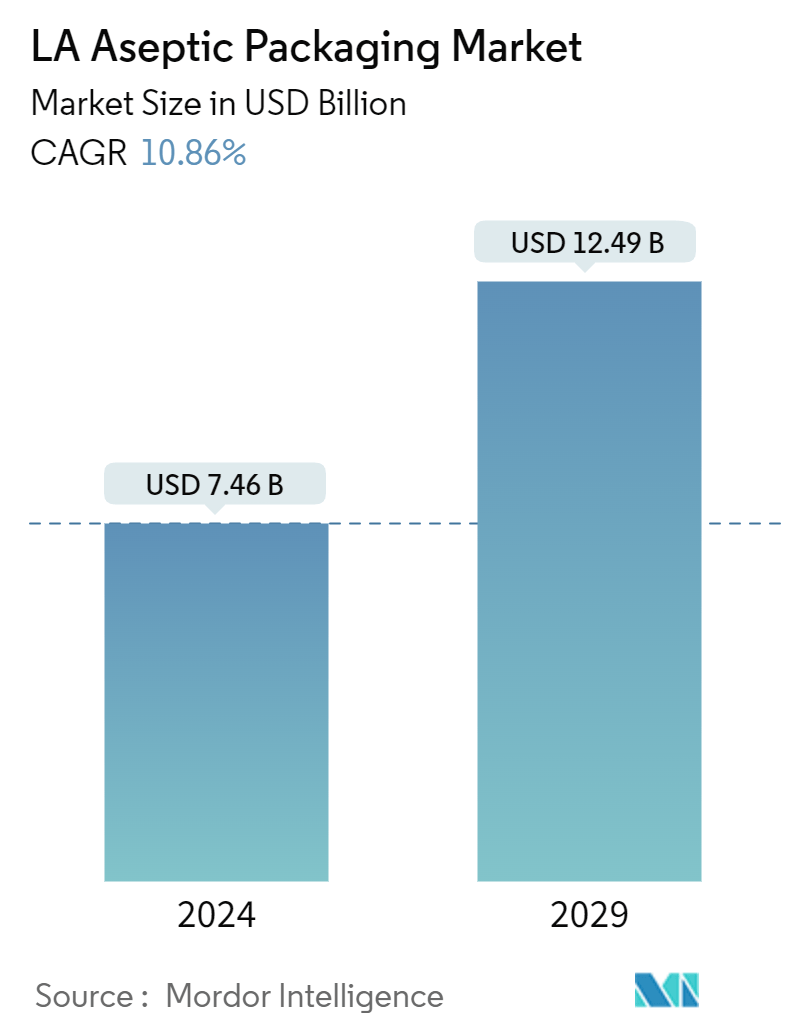
| Study Period | 2019 - 2029 |
| Base Year For Estimation | 2023 |
| Market Size (2024) | USD 7.46 Billion |
| Market Size (2029) | USD 12.49 Billion |
| CAGR (2024 - 2029) | 10.86 % |
| Market Concentration | Medium |
Major Players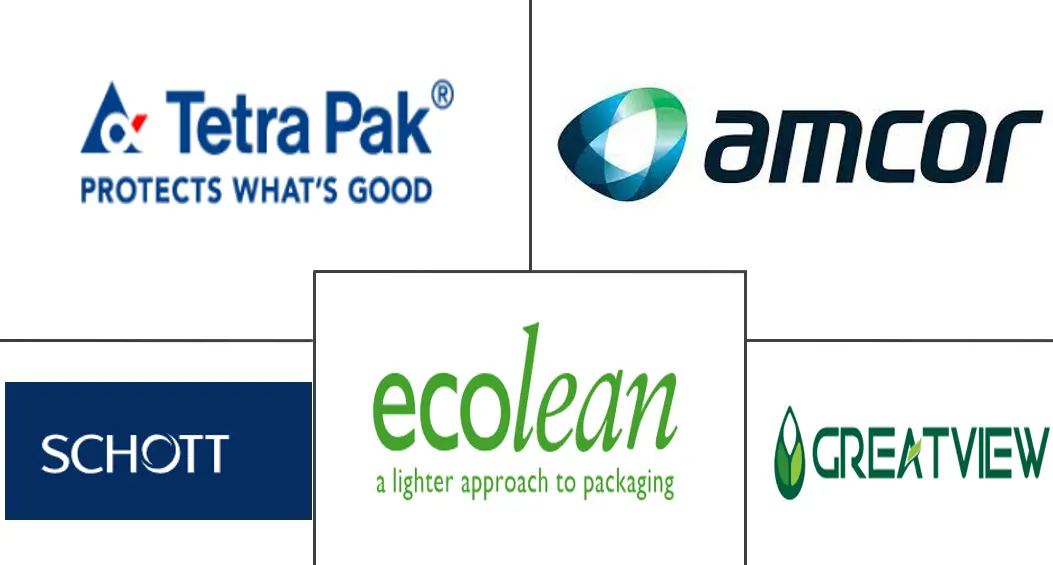
*Disclaimer: Major Players sorted in no particular order |
Latin America Aseptic Packaging Market Analysis
The LA Aseptic Packaging Market size is estimated at USD 7.46 billion in 2024, and is expected to reach USD 12.49 billion by 2029, growing at a CAGR of 10.86% during the forecast period (2024-2029).
- Latin America offers excellent potential in the market studied as a region that produces a lot of raw resources and food products. Rapid industrialization in countries like Brazil, Argentina, Columbia, and Mexico is driving economic growth. As in other continents, the use of new, more environmentally friendly technology is paving the way for the provision of reactions and solutions along the whole food chain to the trend of rising responsible and conscious consumption. These developments are most apparent throughout the processing and preservation stages when they assure quality and safety and extend the food's shelf life. Aseptic packaging is becoming increasingly popular as a safer and more profitable food packaging option.
- Consumers' preference for healthier alternatives is leading to a surge in investment in aseptic packaging despite the potential technical and cost issues associated with the formats. As aseptic designs become increasingly popular due to consumer preference for healthier alternatives, manufacturers are investing in packaging and fill technologies to meet this demand. In Brazil, product development is being driven by consumer preference for functional and healthier options. Dairy companies are focusing on installing aseptic fill machines to cater to the increasing demand for dairy-based products.
- In line with this, Shefa and Líder Alimentos, two Brazilian dairy companies, selected SIG as their preferred partner for supplying and installing aseptic fillers and packaging solutions. SIG is the provider of advanced aseptic fill technology in Brazil. It installed nine aseptic fill machines at production sites in São Paulo and Paraná, where the systems have already started operating.
- Ball Corporation announced it was expanding its operations in South America, landing in Peru with a new manufacturing plant in Chilca. After expansion, the plant will have a production capacity of over 1 billion beverage cans annually. Premiumization has been a critical growth driver for players in the alcohol space due to consumers' continued desire for refreshing and newer tastes and premium packaging. The companies in the industry have been focused on investing in crafting a diverse portfolio of global and specialty premium brands.
- Additionally, the growing demand for soft drinks and other non-alcoholic beverages in Mexico is expected to support the need for aseptic packaging in the forecast timeframe. For instance, according to the National Institute of Statistics and Geography (INEGI), the production value of flavored soft drinks in Mexico amounted to over MXN 3474.71 million (USD 207.05 million) in April 2023, compared to MXN 2811.06 million (USD 167.51 million) in February 2023.
- However, it is difficult to remove this material from packaging due to the presence of aluminum and polyethylene components in aseptic cartooning. To achieve accurate recycling (where materials are recycled to a previous stage of the production cycle without loss of quality), all the layers of Tetra Pak would need to be separated and reused to produce more Tetra Pak. Additionally, the availability of such machines is limited to certain players. Recycling requires a lot of equipment and inputs, such as water and energy, and many recycling centers do not have these. Such factors might hinder market growth.
Latin America Aseptic Packaging Market Trends
Aseptic Cartons to Witness Increased Demand in the Market Studied
- Aseptic cartons are food containers built from multi-layer packing, particularly for liquids like orange juice and soups. These containers are made of layers of paper, plastic, and metal. Once processed into a clean stream, the material is recyclable. Aseptic cartons are made up of approximately 70% paper (for stiffness and strength), roughly 24% polyethylene (used in four layers to seal the package hermetically), and nearly 6% aluminum foil (used as a barrier against air and light). The boxes keep liquids safe for a year or longer without refrigeration.
- As a result, food and beverage vendors are inclining toward aseptic packaging, considering cost and environmental benefits, especially in terms of ambient shipping and storage. Also, as aseptic packaging supports packaging through recyclable and eco-friendly pouches, which often target consumers who prefer small quantities and make purchases more frequently, the demand for such products is considerably high.
- This growth has been primarily driven by the increasing popularity of convenience and ready-to-eat products and the improvement in preservation technologies. In addition, the rising demand for organic and healthy foods has also led to the increased use of aseptic packaging in Brazil. Major aseptic packaging manufacturers, such as Tetra Pak, Amcor, and SIG Combibloc, have invested heavily in Brazil and are expected to continue in the coming years.
- Changing lifestyles and the consequent dependence of consumers on processed, packaged, and pre-cooked food and beverages are increasing the demand for aseptic packaging solutions. The advent of the supermarket culture has also altered the shopping landscape and has increased the need for packaging, especially in food and beverage products. The altering lifestyle of people has resulted in the shift to ready-to-eat products. In addition, these products are packed in aseptic packaging to ensure that the products remain uncontaminated, tamper-proof, and safe for consumption.
- Aseptic cartons for milk are processed at extremely high temperatures, which destroy any harmful bacteria in the milk. The milk is then instantly cartooned in a sterile environment into specialized packaging that prevents air from penetrating. The shelf-life of the milk becomes much longer after this operation. The demand for aseptic cartons for milk is increasing globally, as they protect the product from light and ambient oxygen, resulting in increased shelf life.
- According to the US Department of Agriculture, the Mexican dairy industry produced 13.42 million liters of milk in 2023, up from around 12.54 million metric tons in 2018. Such production growth is expected to support the market growth during the forecast period.
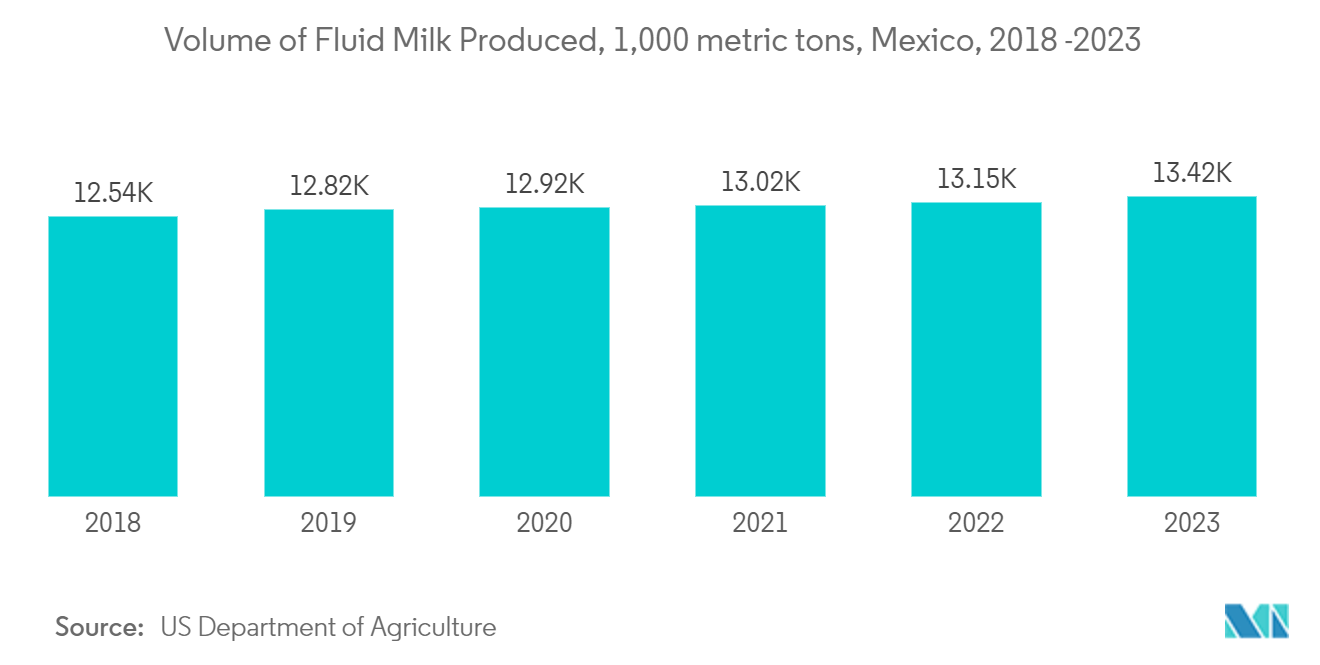
Brazil is Expected to Hold a Significant Share
- The Brazilian food industry is one of the primary consumers of aseptic packing, which extends the shelf life of food products and reduces contamination. Packaging is also employed in the pharmaceutical and medical sectors to minimize spoilage, improve product safety, and ensure product safety when used with sterilization or other packaging technologies.
- Market players invest in research and development to stay ahead of developing industries. Market trends in new product launches support market demand. Notably, the pharmaceutical industry's demand for aseptic packaging is also increasing. Governments across the country are increasing regulations on the healthcare sector to boost the growth of the aseptic packaging market.
- The Ministry of Health in Brazil regulates aseptic packing and ensures that it complies with the country's Good Manufacturing Practices regulations. Additionally, the Brazilian government established a Working Group in 2019 to discuss and develop strategies for using aseptic packing in Brazil.
- The aseptic packaging market is expected to expand in the country exponentially over the next couple of years. The growth rates included ready meals, breakfast cereals, baby food, sauces, dressings and condiments, processed meat, seafood, and soup. According to the Organic Trade Association, the consumption of organic packaged food and beverages in Brazil is expected to increase from USD 74 million in 2020 to USD 105 million in 2025.
- The market is expected to grow in the coming years as new technologies and innovations enable manufacturers to create more efficient and sustainable aseptic packaging solutions. Increasing consumption of alcoholic beverages in the region will boost the use of the bag in the box for wine packaging, cans for beers, and bottles for spirits. For instance, according to an article published by Banco do Nordeste, the consumption of alcoholic beverages in Brazil is expected to reach 12.29 billion liters by 2024 from 11.09 billion liters in 2021.
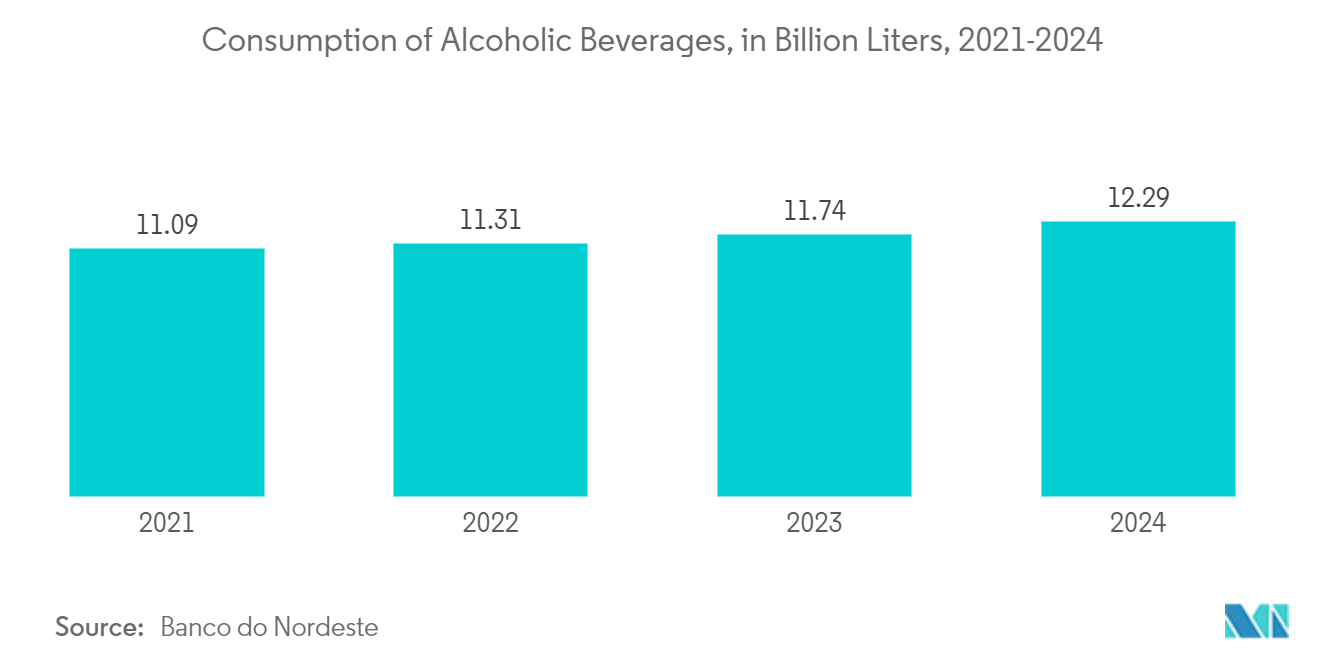
Latin America Aseptic Packaging Industry Overview
The Latin American aseptic packaging market is semi-consolidated, as a few vendors operate in the domestic and international markets. The market appears to be moderately consolidated, with the players adopting various strategies, such as product innovation, mergers, and acquisitions, to expand their reach and stay competitive. Some of the major players in the market are Bemis Company Incorporation, DS Smith PLC, SIG Combibloc Group AG, and Tetra Pak International.
- In March 2023, Chile-based NotCo, a food-tech unicorn, partnered with SIG, enabling NotCo to launch NotCreme, a plant-based alternative to animal-derived food products, in SIG's carton packaging. This partnership further strengthens NotCo's expertise and adaptability in plant-based foods. NotMilk Originals, zero-sugar, semi-sugar, and chocolate milk products will also be available in aseptic carton packs from SIG.
Latin America Aseptic Packaging Market Leaders
-
Amcor PLC
-
Schott AG
-
Ecolean Packaging
-
Greatview Aseptic Packaging
-
Tetra Pak International SA
*Disclaimer: Major Players sorted in no particular order
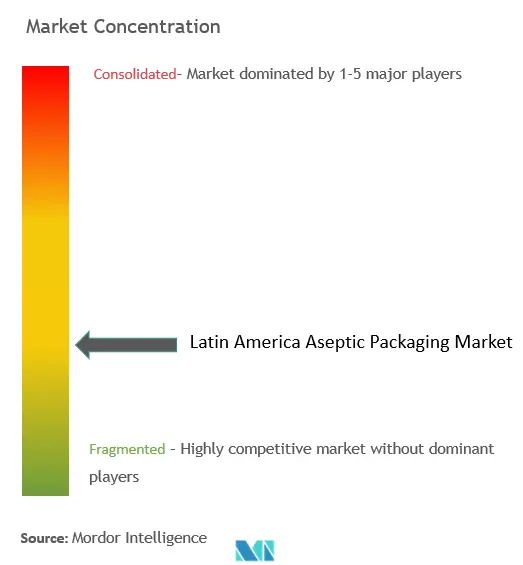
Latin America Aseptic Packaging Market News
- March 2024: SIG, a leading aseptic carton supplier, has established a strategic partnership with DPA Brasil, a prominent dairy company, to launch spouted pouch packaging for its Chamyto yoghurt brand. The innovative spouted pouch, featuring the SIG CloverCap 85RO closure and filled using SIG Prime 120 equipment, offers a lightweight yet durable design. This design significantly enhances ease of consumption, particularly for children.
- August 2023: Unither Pharmaceuticals recently purchased the Novartis facility in São Paulo as part of its strategic growth plan in the Brazilian market. As stated by its president, this acquisition allows Unither Pharmaceuticals to take advantage of aseptic operations in Latin America and expand its range of multidose ophthalmic containers.
Latin America Aseptic Packaging Market Report - Table of Contents
1. INTRODUCTION
- 1.1 Study Assumptions and Market Definition
- 1.2 Scope of the Study
2. RESEARCH METHODOLOGY
3. EXECUTIVE SUMMARY
4. MARKET DYNAMICS
- 4.1 Market Overview
- 4.2 Industry Value Chain Analysis
-
4.3 Industry Attractiveness - Porter's Five Forces Analysis
- 4.3.1 Bargaining Power of Suppliers
- 4.3.2 Bargaining Power of Buyers
- 4.3.3 Threat of New Entrants
- 4.3.4 Threat of Substitute Products
- 4.3.5 Intensity of Competitive Rivalry
5. MARKET DYNAMICS
-
5.1 Market Drivers
- 5.1.1 Growing Demand for Aseptic Packaging in the Food and Beverage Industry
-
5.2 Market Challenges
- 5.2.1 Difficulty in Recycling the Packaging Material
6. MARKET SEGMENTATION
-
6.1 By Product
- 6.1.1 Cartons
- 6.1.2 Bags and Pouches
- 6.1.3 Cans
- 6.1.4 Bottles
-
6.2 By Application
- 6.2.1 Beverages
- 6.2.1.1 Ready-to-Drink
- 6.2.1.2 Dairy-based Beverages
- 6.2.2 Food
- 6.2.2.1 Processed Food
- 6.2.2.2 Fruits and Vegetables
- 6.2.2.3 Dairy Food
- 6.2.3 Pharmaceutical
-
6.3 By Country***
- 6.3.1 Brazil
- 6.3.2 Argentina
- 6.3.3 Mexico
7. COMPETITIVE LANDSCAPE
-
7.1 Company Profiles
- 7.1.1 Amcor PLC
- 7.1.2 Bemis Company Inc.
- 7.1.3 DS Smith PLC
- 7.1.4 Elopak AS
- 7.1.5 Mondi PLC
- 7.1.6 Reynold Group Holdings PLC
- 7.1.7 Sonoco Products Company
- 7.1.8 Smurfit Kappa Group PLC
- 7.1.9 SIG Combibloc Group AG
- 7.1.10 Stora Enso Oyj
- *List Not Exhaustive
8. INVESTMENT ANALYSIS
9. FUTURE OF THE MARKET
** Subject To AvailablityLatin America Aseptic Packaging Industry Segmentation
The study tracks consumer demand based on sales of aseptic packaging products offered by various vendors operating in the global market. The study factors in the impact of geopolitical scenarios on the overall supply chain of the market. The study factors the prevalent base scenarios, key themes, and end-user vertical-related demand cycles.
The Latin American aseptic packaging market is segmented by products (cartons, bags and pouches, cans, bottles, and other products), application (beverage [ready-to-drink, dairy-based beverages, others], food [processed food, fruits and vegetables, dairy food, and others], and pharmaceutical), and country (Brazil, Argentina, Mexico, and Rest of Latin America). The market sizes and forecasts are provided in terms of value (USD) for all the above segments.
| By Product | Cartons | |
| Bags and Pouches | ||
| Cans | ||
| Bottles | ||
| By Application | Beverages | Ready-to-Drink |
| Dairy-based Beverages | ||
| By Application | Food | Processed Food |
| Fruits and Vegetables | ||
| Dairy Food | ||
| By Application | Pharmaceutical | |
| By Country*** | Brazil | |
| Argentina | ||
| Mexico |
Latin America Aseptic Packaging Market Research FAQs
How big is the Latin America Aseptic Packaging Market?
The Latin America Aseptic Packaging Market size is expected to reach USD 7.46 billion in 2024 and grow at a CAGR of 10.86% to reach USD 12.49 billion by 2029.
What is the current Latin America Aseptic Packaging Market size?
In 2024, the Latin America Aseptic Packaging Market size is expected to reach USD 7.46 billion.
Who are the key players in Latin America Aseptic Packaging Market?
Amcor PLC, Schott AG, Ecolean Packaging, Greatview Aseptic Packaging and Tetra Pak International SA are the major companies operating in the Latin America Aseptic Packaging Market.
What years does this Latin America Aseptic Packaging Market cover, and what was the market size in 2023?
In 2023, the Latin America Aseptic Packaging Market size was estimated at USD 6.65 billion. The report covers the Latin America Aseptic Packaging Market historical market size for years: 2019, 2020, 2021, 2022 and 2023. The report also forecasts the Latin America Aseptic Packaging Market size for years: 2024, 2025, 2026, 2027, 2028 and 2029.
Latin America Aseptic Packaging Industry Report
Statistics for the 2024 LA Aseptic Packaging market share, size and revenue growth rate, created by Mordor Intelligence™ Industry Reports. LA Aseptic Packaging analysis includes a market forecast outlook to 2029 and historical overview. Get a sample of this industry analysis as a free report PDF download.



